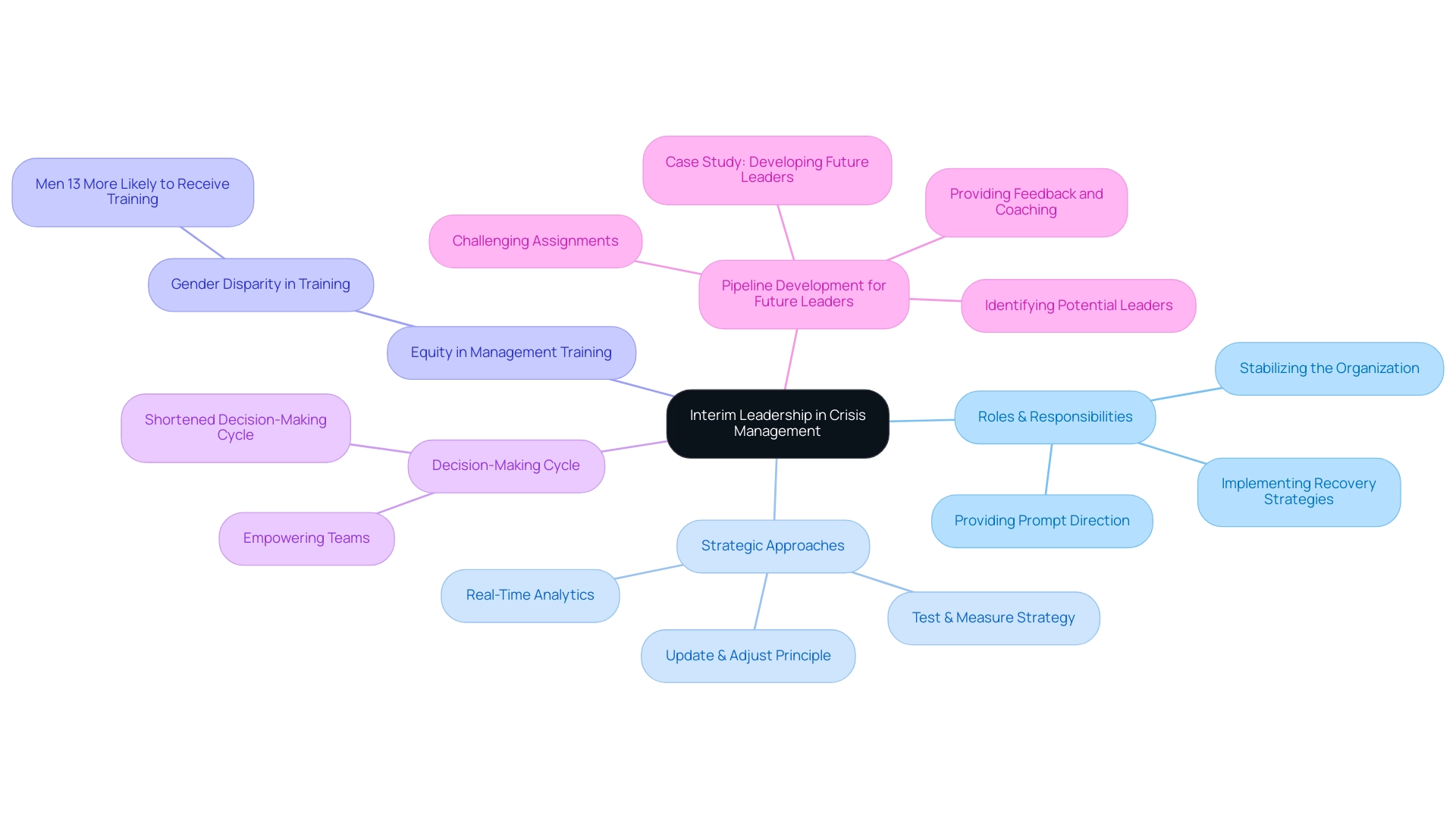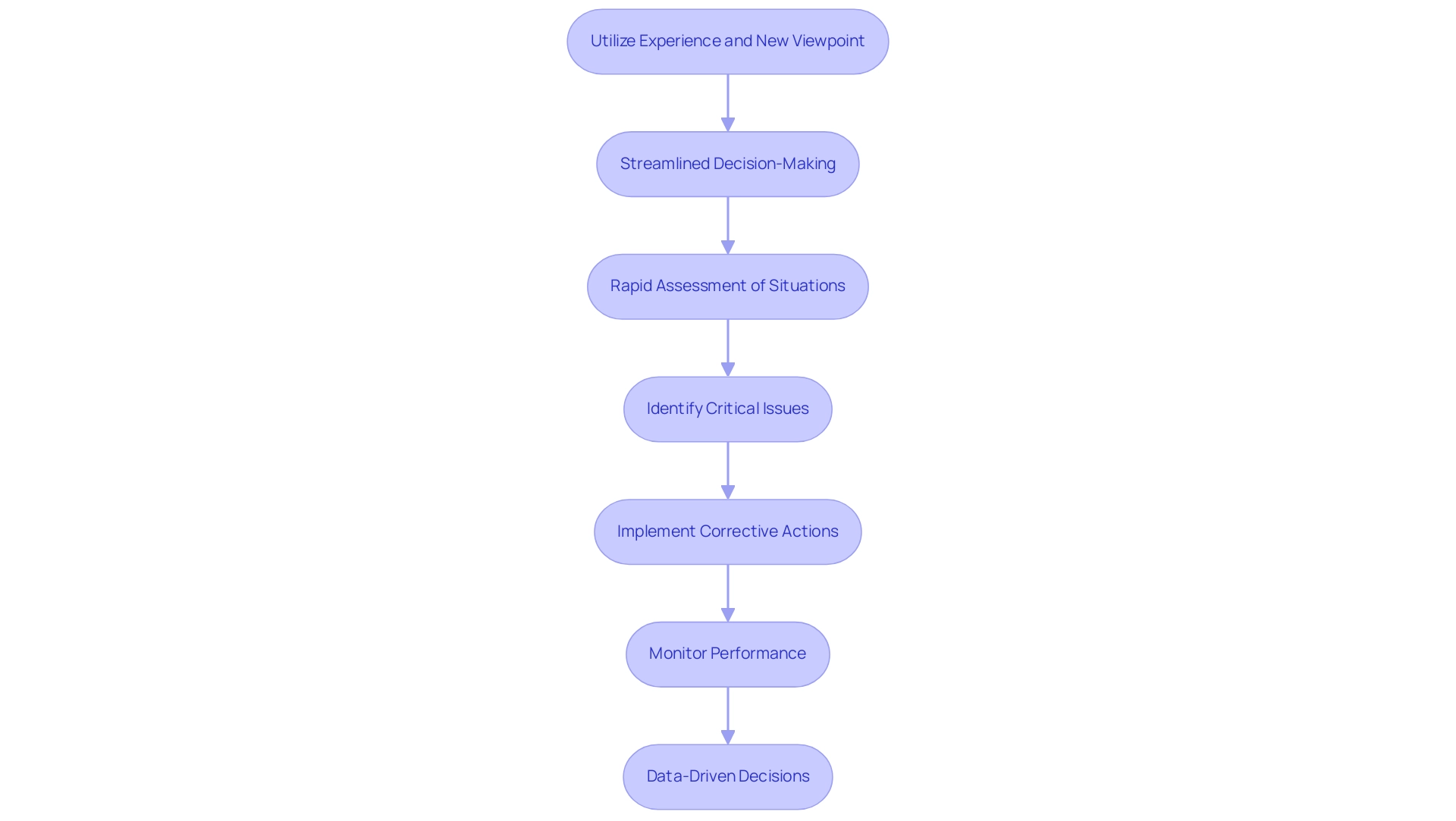Introduction
In times of crisis, organizations often find themselves at a crossroads, where decisive leadership can mean the difference between recovery and further decline. Interim leaders emerge as vital assets, equipped with the specialized skills and fresh perspectives necessary to navigate turbulent waters. Their strategic appointment during critical junctures allows for immediate stabilization and the implementation of recovery strategies that not only address pressing challenges but also lay the groundwork for future resilience.
By leveraging real-time analytics and fostering a culture of adaptability, these leaders facilitate swift decision-making and effective stakeholder communication, ensuring that organizations can pivot and thrive in the face of adversity. As the landscape of crisis management continues to evolve, understanding the transformative potential of interim leadership becomes essential for any organization aiming to emerge stronger and more resilient.
Defining Interim Leadership in Crisis Management
Interim leadership for crisis in emergency management entails the strategic short-term selection of individuals with specialized skills and vast experience to guide organizations through turbulent periods. These temporary executives are often called upon for interim leadership for crisis situations, such as financial downturns, operational failures, or when there is a leadership vacuum. Their main duty is to stabilize the organization by providing prompt direction, making decisive and occasionally difficult decisions, and implementing recovery strategies that are essential for managing challenges effectively.
Interim leadership for crisis can significantly influence an organization's trajectory, ensuring that not only are immediate challenges addressed but also that a foundation is laid for future resilience. To enhance the turnaround process, our approach includes:
- Testing hypotheses to drive maximum return on invested capital, which aligns with our 'Test & Measure' strategy.
- Supporting a shortened decision-making cycle that empowers your team to take decisive action.
Furthermore, we utilize real-time analytics through our client dashboard to continually monitor the success of our plans, enabling us to diagnose business health proactively and adjust strategies as necessary, reflecting our commitment to the 'Update & Adjust' principle. As Dr. Frederik von Briel insightfully notes,
This requires you to evaluate whether change will allow you to shape your market offering, your organization, or the processes you engage in.
Additionally, it is essential to consider that men are 13% more likely to receive training for management roles than women, highlighting the need for equitable development in crisis management.
Risking social license jeopardizes community, employee, and investor support, which is difficult to restore after damage. Organizations must also concentrate on building a pipeline of qualified candidates for managerial roles, as illustrated in the case study titled 'Developing Future Leaders.' By providing feedback, coaching, and challenging assignments, companies can prepare employees for future managerial roles, addressing the impending gap in management.
By understanding these dynamics and applying the lessons learned from the turnaround process, organizations can utilize interim leadership for crisis as a strategic asset, thereby reinforcing their capacity to recover and thrive in the face of adversity.

The Essential Role of Interim Leaders in Navigating Crises
In the area of emergency management, interim leadership for crisis is essential, as it utilizes vast experience and a new viewpoint to steer organizations through challenging periods. They employ a streamlined decision-making process that supports rapid assessments of complex situations, enabling them to pinpoint critical issues and implement immediate corrective actions that stabilize operations. A study conducted during August–September 2020 highlights the critical role these individuals play in navigating emergencies, demonstrating that their essential skills in emergency communication, stakeholder engagement, and operational restructuring provide interim leadership for crisis, enabling them to tackle challenges effectively and maintain organizational momentum.
Furthermore, the role of interim leadership for crisis is often filled by leaders who come equipped with a proven track record in similar situations, fostering confidence among employees and stakeholders alike. As C. Forster indicated, 'All authors read and approved the final manuscript,' highlighting the collaborative effort in comprehending emergency guidance. Insights from the case study titled 'Overall Effectiveness of Crisis Management' reveal that such guidance explained a significant portion of the variance in organizational effectiveness, highlighting the importance of various attributes in managing emergencies.
By continually monitoring performance through real-time analytics via a client dashboard and applying the lessons learned from previous challenges, temporary managers facilitate swift action and enhance the likelihood of successful organizational recovery. Additionally, their approach includes testing hypotheses to ensure that decisions are data-driven and effective.

Advantages of Interim Leadership for Crisis Resilience
Utilizing interim leadership for crisis during emergencies provides multiple benefits that strengthen organizational resilience. Initially, the interim leadership for crisis introduces flexibility to decision-making processes, enabling quick reactions to changing circumstances, aided by real-time analytics that track business health via a client dashboard. Their expertise in emergency management enables them to implement best practices and proven strategies, including rigorous testing of hypotheses, which is crucial for interim leadership for crisis to maximize the return on invested capital.
Furthermore, temporary supervisors can frequently offer cost-efficient solutions, as they are usually involved on a short-term basis, lowering the long-term financial strain on the organization. This flexibility allows companies to focus resources on recovery and stabilization efforts while operationalizing the lessons learned throughout the turnaround process, ensuring continuous improvement and adaptation.
Strategic Contributions of Interim Leaders to Crisis Management
Interim leadership for crisis is crucial as temporary leaders play a pivotal role in managing emergencies by crafting comprehensive recovery plans that encompass both immediate responses and long-term objectives. Our comprehensive services in turnaround and restructuring consulting, including financial assessment and bankruptcy case management, combined with practical temporary management, ensure that small to medium businesses receive the expert guidance they need during turbulent times. Their expertise in stakeholder communication ensures that all relevant parties stay informed and aligned throughout the situation, which is essential for successful navigation.
Statistics suggest that temporary management typically entails providing effective business solutions for a limited period, usually ranging from 6 to 12 months, underscoring the urgency and significance of their role. For instance, after a recent crisis, our interim leadership for crisis has been instrumental in rebuilding and recovery efforts, enabling companies to not only stabilize but also emerge stronger. These leaders leverage their external perspectives to implement innovative recovery strategies, often challenging the status quo and driving necessary changes.
A significant example is Consultport, which identified two qualified candidates within 48 hours, leading to the appointment of a temporary Chief Revenue Officer with substantial healthcare management experience. This individual successfully introduced performance-enhancing processes that markedly improved operational efficiency and patient care. As Vineet Arya aptly states, 'Embracing interim leadership for crisis is not just a tactical choice but a strategic advantage in today’s rapidly evolving business environment.'
Ultimately, temporary managers promote collaboration across teams and departments, significantly enhancing organizational cohesion and encouraging a culture of adaptability, which is essential for effective problem resolution. Furthermore, our commitment to streamlined decision-making, real-time analytics, and operationalizing lessons learned ensures that businesses can quickly identify underlying issues and initiate transformational change through our proven Rapid-30 process. Testimonials from our clients highlight the effectiveness of our approach, showcasing successful turnaround stories that underscore our dedication to preserving business value and ensuring long-term survival.
Overcoming Crisis Challenges with Interim Leadership
Crisis situations often introduce a myriad of challenges, such as resistance to change, communication breakdowns, and financial instability. With an economic downturn approaching, those in interim leadership for crisis are specially prepared to tackle these challenges, employing their unique change management abilities and conflict resolution techniques. By fostering a culture of openness and adaptability, they encourage teams to embrace innovative directions and solutions.
This approach is crucial, as it allows organizations to pivot effectively in response to emerging challenges. Moreover, interim managers excel at facilitating transparent communication across all organizational levels, ensuring alignment and keeping everyone informed. Their expertise in managing financial distress enables them to implement strategic cost control measures, steering the organization toward stability and recovery.
As Martha Beck insightfully noted, individuals are not imprisoned by habit; challenges can catalyze significant change. Interim leadership for crisis embodies this principle by guiding organizations to not only endure but also thrive amidst adversity. The case study named 'Crisis and Personal Reflection' emphasizes how such situations encourage individuals to reevaluate their priorities, further highlighting the transformative potential of temporary management.
As Magic Johnson aptly stated, 'When you face a crisis, you know who your true friends are'—this sentiment resonates deeply in the context of interim leadership, where the ability to forge genuine connections and inspire trust is paramount.
Conclusion
Interim leadership stands as a crucial element in navigating the complexities of crisis management. By strategically appointing interim leaders, organizations can leverage their specialized skills and fresh perspectives to swiftly address immediate challenges while laying the groundwork for long-term resilience. These leaders not only stabilize operations through decisive action but also implement recovery strategies that align with best practices, ensuring a robust response to adversity.
The advantages of employing interim leaders are manifold. Their agility in decision-making, combined with real-time analytics, fosters a proactive approach to crisis resolution. This capability enables organizations to adapt and thrive, turning potential setbacks into opportunities for growth. By fostering a culture of transparency and collaboration, interim leaders can effectively engage stakeholders, ensuring that everyone is aligned and informed throughout the recovery process.
Ultimately, the transformative potential of interim leadership cannot be overstated. As organizations face unprecedented challenges, the ability to integrate interim leaders into crisis management strategies is not merely beneficial; it is essential. By embracing this approach, organizations position themselves to not only survive crises but emerge stronger and more resilient, ready to tackle future challenges with confidence and agility.
Frequently Asked Questions
What is interim leadership for crisis in emergency management?
Interim leadership for crisis involves the strategic short-term selection of individuals with specialized skills and extensive experience to guide organizations through challenging periods, such as financial downturns or operational failures.
What are the main responsibilities of interim leaders during a crisis?
Their primary duty is to stabilize the organization by providing prompt direction, making decisive decisions, and implementing recovery strategies essential for managing challenges effectively.
How does interim leadership influence an organization's future?
It not only addresses immediate challenges but also lays a foundation for future resilience, ensuring that organizations can recover and thrive in the face of adversity.
What strategies are employed by interim leaders to enhance turnaround processes?
They test hypotheses to maximize return on invested capital and support a shortened decision-making cycle that empowers teams to take decisive action.
How do interim leaders utilize analytics in crisis management?
They use real-time analytics through client dashboards to monitor the success of their plans, diagnose business health proactively, and adjust strategies as necessary.
What is the significance of equitable development in crisis management?
It highlights that men are 13% more likely to receive training for management roles than women, emphasizing the need for equitable development opportunities in crisis management.
Why is it important for organizations to build a pipeline of qualified candidates for managerial roles?
Building a pipeline is crucial for preparing employees for future managerial roles and addressing the impending gap in management, ensuring sustained organizational effectiveness.
What benefits does interim leadership bring during emergencies?
Interim leadership introduces flexibility to decision-making, enables quick reactions to changing circumstances, and can often provide cost-efficient solutions due to their short-term involvement.
How do interim leaders facilitate collaboration within organizations?
They promote collaboration across teams and departments, enhancing organizational cohesion and encouraging a culture of adaptability, which is essential for effective problem resolution.
What challenges do interim leaders help organizations navigate during crises?
They address challenges such as resistance to change, communication breakdowns, and financial instability, employing change management and conflict resolution techniques to guide organizations toward stability and recovery.




